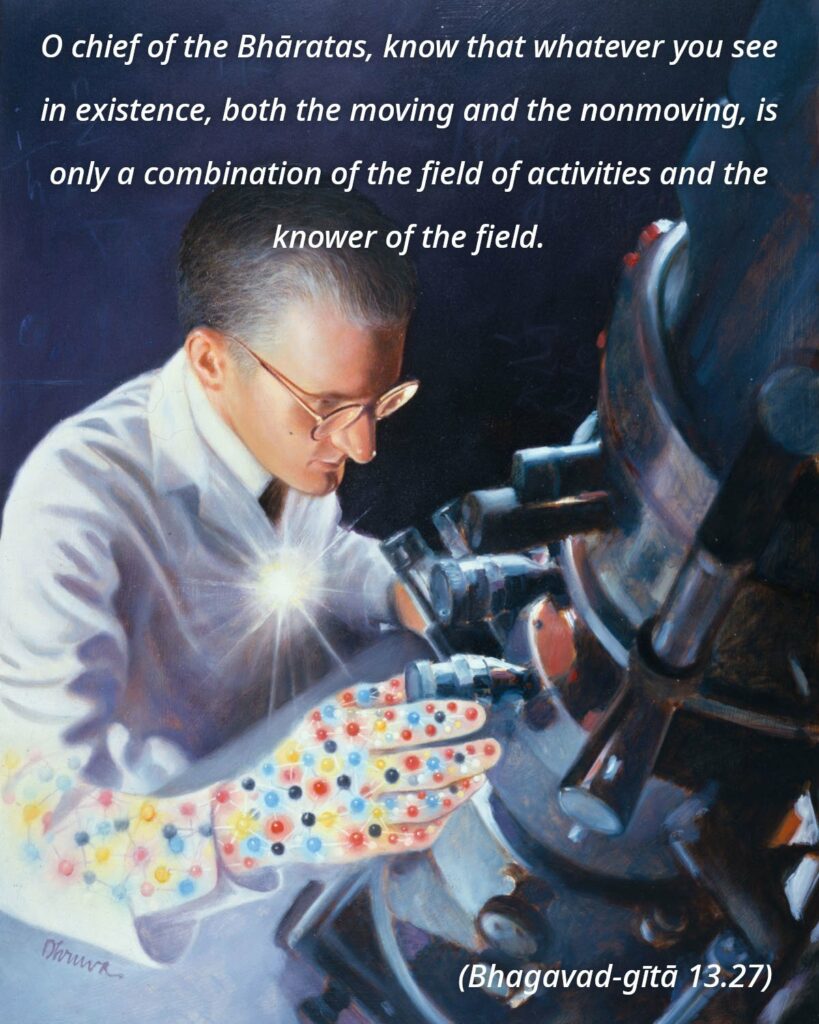यावत्सञ्जायते किञ्चित्सत्वं स्थावरजङ्गमम् |
क्षेत्रक्षेत्रज्ञसंयोगात्तद्विद्धि भरतर्षभ || 27||
yāvat sañjāyate kiñchit sattvaṁ sthāvara-jaṅgamam
kṣhetra-kṣhetrajña-sanyogāt tad viddhi bharatarṣhabha
yāvat—whatever; sañjāyate—manifesting; kiñchit—anything; sattvam—being; sthāvara—unmoving; jaṅgamam—moving; kṣhetra—field of activities; kṣhetra-jña—knower of the field; sanyogāt—combination of; tat—that; viddhi—know; bharata-ṛiṣhabha—best of the Bharatas
Translation:
Whatever is born— whether animate or inanimate— know, Ο Bhārata prince, that it is through union of the Field and the Knower of the Field.
Commentary:
The presence of the Lord in everything in the world is declared here. The moving and non-moving objects, whatever they are, all of them and every one of them, are produced by the union of Prakriti and Purusha (kshetra and kshetrajna). Knowing this man has to cultivate universal love as the rule of conduct in life. Does God exist in the stone? The answer is that the stone cannot have any existence at all, without the union with the Lord. The stone as stone would not be there. This being so, is it any wonder that the Lord is present in living beings, animals, birds or men? So in the trees and mountains, rivers and valleys, fields and meadows, in the ant, in the sparrow, in the deer and the tiger, in men, in demons and the Gods, Paramatma exists. Such faith is needed for God-realisation.
Sri Ramakrishna Says —
Doctor Sarkar, who was a homeopath, gave Sri Ramakrishna two globules of medicine. He said, “I am giving you these two globules: one is Purusha and the other is Prakriti.” (All laugh.)
MASTER (smiling): “Oh yes, Purusha and Prakriti are always together. Haven’t you observed pigeons? The male and female cannot live separately. Wherever Purusha is, there is Prakriti, and wherever Prakriti is, there is Purusha.”
It was Vijaya day. Sri Ramakrishna asked Dr. Sarkar to have some refreshments. The devotees served him with sweets.
DOCTOR (while eating): “Now I say ‘Thank you’ for the sweets; but it is not for your teachings. Why should I give that ‘Thank you’ in words?”
MASTER (smiling): “The essential thing is to fix the mind on God and to practise meditation a little. What more shall I say? (Pointing to the younger Naren) Look at him. His mind totally merges in God. Those things I was telling you —”
DOCTOR: “Tell the others also.”
MASTER: “No, a man should be given food according to his power of digestion. Can all understand what I told you? I cannot talk to everyone as I talked to you. Suppose a mother has bought a fish for the family. All her children have not the same power of digestion. For some she makes pilau and for others she makes stew. These latter have weak stomachs.” (All laugh.) (Source: Gospel of Sri Ramakrishna)
—–
“Weeping, I prayed to the Mother: ‘O Mother, reveal to me what is contained in the Vedas and the Vedanta. Reveal to me what is in the Purana and the Tantra.’ One by one She has revealed all these to me.
“Yes, She has taught me everything. Oh, how many things She has shown me! One day She showed me Siva and Sakti everywhere. Everywhere I saw the communion of Siva and Sakti. Siva and Sakti existing in all living things — men, animals, trees, plants. I saw Them in the communion of all male and female elements. (Source: Gospel of Sri Ramakrishna)
Ramcharitmanas (Lanka Kand)
“Siyaramamaya saba jaga jani, karahu pranama jori juga pani.”
“Know the entire world to be pervaded by Sita and Rama; bow to it with folded hands.”
Related Articles:
- Know this (Prakriti) to be the womb of all beings; I am the source of the outcoming of the whole universe, and like-wise the source of its dissolution. (BG 7.6)
- And that which is the seed of all beings— that am I, Ο Arjuna. There is no being, whether moving or unmoving, that can exist without Me. (BG 10.39)
Question: How are the moving and non-moving objects produced?
Answer: They are produced by the union of ‘kshetra’ and ‘kshetrajna’.
Bhagavad Gita: Chapter 13 🔻 (35 Verses)
